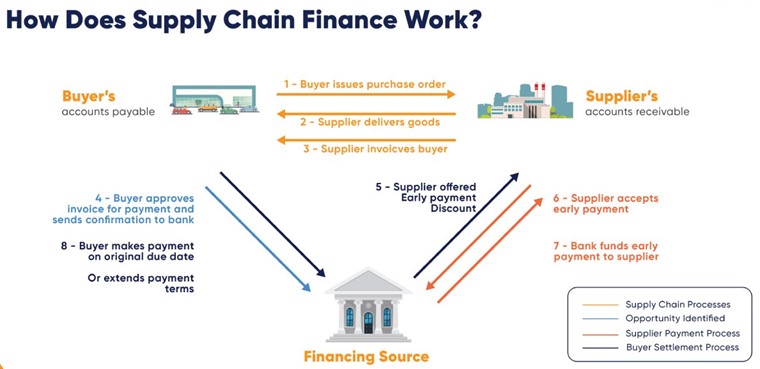Prologue
- The global Supply Chain Finance (SCF) market was valued at $50 billion in 2022 and is projected to grow at a compound annual growth rate (CAGR) of 15-20% between 2023 and 2030, reflecting increasing adoption across industries.
- Vendors participating in SCF programs experience a 20-30% reduction in financing costs compared to traditional borrowing, leveraging the client’s creditworthiness.
- During the COVID-19 pandemic, SCF programs helped maintain supply chain stability, with over 80% of businesses acknowledging SCF as a critical tool to support vendors during disruptions.
Overview of Supply Chain Finance
Supply Chain Finance (SCF) is a set of financial solutions aimed at optimizing cash flow and improving liquidity for businesses involved in a supply chain. It focuses on enabling suppliers (vendors) to receive early payments for their invoices while allowing buyers (clients) to extend their payment terms. SCF programs are facilitated by third-party financial institutions and often managed through digital platforms to ensure efficiency and transparency.

Key Stakeholders in SCF
- Suppliers (Vendors): Vendors are suppliers of goods or services who benefit from early payments, improving their cash flow and operational stability:
- Buyers (Clients): Buyers, are the organizations purchasing goods or services, using SCF to extend payment terms while ensuring vendor liquidity and maintaining a reliable supply chain.
- Financial Institutions: Financial institutions, such as banks or fintech companies, facilitate SCF by providing the necessary funding to enable early payments to vendors.SCF Platforms: Digital tools or software that streamline SCF transactions.
Core Mechanisms
SCF relies on three core mechanisms:
- Invoice Financing: Vendors can receive early payment for approved invoices, often at a lower cost of capital due to the creditworthiness of the client.
- Reverse Factoring: Financial institutions pay vendors early and collect payment from clients on the agreed due date.
- Dynamic Discounting: Clients offer early payments to vendors in exchange for discounts on invoice amounts.
Benefits of SCF for Vendors
Improved Cash Flow:
SCF enables vendors to access early payments for their invoices, reducing reliance on long payment cycles. This enhances their liquidity, allowing them to meet financial obligations and reinvest in their operations.
Reduced Financing Costs:
By leveraging the client’s creditworthiness, vendors can secure funding at lower interest rates compared to traditional loans, making financing more affordable and efficient.
Stabilized Operations:
With timely payments, vendors can maintain steady production and inventory levels, ensuring they can meet client demands without disruption or delays.
Increased Financial Predictability:
SCF offers vendors a predictable cash flow, reducing uncertainty and enabling better planning for future investments, growth, and expansion.
Strengthened Vendor-Client Relationships:
By participating in SCF, vendors foster trust and collaboration with clients, positioning themselves as reliable partners for long-term business success.
Benefits of SCF for Clients
Extended Payment Terms:
SCF allows clients to extend payment terms without negatively impacting their suppliers’ liquidity. This flexibility improves the client’s cash flow management and gives them more time to utilize working capital for other business needs, all while maintaining supplier relationships.
Improved Supplier Stability:
By facilitating early payments to vendors, SCF ensures that suppliers have access to the funds they need to continue operations smoothly. This stability reduces the risk of supply chain disruptions due to financial stress among suppliers, which benefits the client’s business continuity.
Cost Savings through Dynamic Discounting:
Clients can negotiate early payment discounts through SCF programs, offering them the opportunity to reduce procurement costs. In exchange for early payments, suppliers may offer price reductions, resulting in direct savings for the client while enhancing supplier loyalty.
Risk Mitigation in Supply Chain:
SCF reduces the risk of vendor insolvency by ensuring that suppliers are paid promptly. By strengthening the financial health of key suppliers, clients can avoid potential disruptions in the supply chain that could result from vendor bankruptcies or operational slowdowns.
How SCF Strengthens Vendor-Client Relationships ?
Supply Chain Finance (SCF) strengthens vendor-client relationships by addressing financial challenges, promoting collaboration, and building trust between both parties. SCF is widely adopted in industries with complex supply chains, such as retail, manufacturing, and healthcare, and its role continues to grow as businesses embrace digitalization and sustainability goals. Here are the key ways SCF enhances these relationships:

- Enhances cash flow: SCF identifies trapped cash in the Supply chain and provides suppliers with early payments on their invoices. For buyers, it allows the extension of payment terms, giving them better control over their cash resources without harming supplier relationships.
- Reduces risk: By leveraging the creditworthiness of buyers, who are often more financially stable than suppliers, SCF reduces risk for the financing party. This setup ensures financial stability across the supply chain, creating a win-win situation for all parties involved.
- Strengthens supply chain relationships: SCF builds stronger partnerships between buyers and suppliers, promoting mutual confidence, transparency and better collaboration.
- Accessible to various businesses: With 40% of SMEs in developed markets now using SCF, these solutions are now increasingly democratized, offering never-before growth opportunities for smaller players as well as larger enterprises.
- Leverages technological platforms: The adoption of digital SCF platforms are making transactions more transparent, faster and easier to manage and this is expected to grow in the next decade. Technology streamlines the SCF process and offers data analysis and insights, enabling informed decision-making.
Role of Technology in Supply Chain Finance
Technology plays a transformative role in enabling and optimizing Supply Chain Finance (SCF) programs by streamlining processes, improving transparency, and enhancing efficiency. Digital platforms, advanced analytics, and automation have made it easier for buyers, suppliers, and financial institutions to collaborate effectively. Technology simplifies the onboarding of vendors and integrates seamlessly with enterprise resource planning (ERP) systems, ensuring real-time access to transactional data such as invoices, payments, and credit information.
Key technologies like blockchain enhance security and transparency by creating immutable records of transactions, reducing fraud risks and disputes. Artificial intelligence (AI) and machine learning (ML) enable predictive analytics, which can assess supplier credit risk, forecast cash flow needs, and optimize financing terms. Furthermore, cloud-based SCF platforms provide centralized and scalable solutions that allow stakeholders to manage financing operations from anywhere, breaking down geographical barriers, especially in global supply chains.
Digital automation also accelerates processes like invoice validation, approval workflows, and payment execution, minimizing errors and manual intervention. Technology ensures that all stakeholders have real- time visibility into payment statuses, which builds trust and strengthens vendor-client relationships. By making SCF more accessible, efficient, and secure, technology not only reduces operational costs but also empowers businesses to maximize the benefits of supply chain finance programs, fostering a more resilient and collaborative supply chain ecosystem.
Types of Supply Chain Finance
There are several types of Supply Chain Finance (SCF) solutions that cater to different needs of vendors, clients, and financial institutions. Each type of SCF solution offers distinct advantages for improving liquidity, managing cash flow, and fostering collaboration within the supply chain. Below are the key types of SCF:

1. Reverse Factoring (or Supplier Finance):
- In reverse factoring, the buyer (client) works with a financial institution to pay its suppliers early, typically at a discounted rate. The financial institution provides funds to the supplier based on the buyer’s creditworthiness, and the buyer repays the institution at a later date.
- This helps vendors get paid quickly while allowing the buyer to extend payment terms. It improves liquidity for vendors and provides clients with better cash flow management.
2. Dynamic Discounting:
- Dynamic discounting allows clients to offer early payment to their suppliers in exchange for a discount on the invoice amount. The discount rate is typically dynamic, meaning it changes based on how early the payment is made.
- Clients save on procurement costs through discounts, while suppliers benefit from early payments, improving their cash flow. It’s a win-win solution for both parties.
3. Inventory Finance:
- Inventory Financing is a type of Supply Chain Finance (SCF) that allows businesses to use their inventory as collateral to secure funding. This type of financing helps vendors or businesses unlock the value of their unsold stock, providing immediate working capital for operations, procurement, or fulfilling new orders.
- It is a crucial tool for managing liquidity, especially in industries with high stock turnover or seasonal sales.
4. Payables Finance:
- Payables Finance (also known as Buyer or Payable Finance in some contexts) is a type of Supply Chain Finance (SCF) that focuses on the buyer (client) rather than the supplier. It is a financial solution that allows buyers to extend their payment terms to suppliers while providing suppliers with the option to receive early payment, typically facilitated by a financial institution.
- It strengthens supplier-buyer relationships by offering a financial tool that supports operational stability, fosters collaboration, and helps both parties manage their cash flow more effectively
5. Receivables Finance:
- Receivables Finance is a type of Supply Chain Finance (SCF) that focuses on improving a business’s cash flow by allowing them to access immediate funding by selling or borrowing against their outstanding accounts receivable (invoices). It helps businesses manage working capital by unlocking the value of their receivables before customers pay their invoices.
- By supporting suppliers with access to early payment through receivables finance, clients enhance collaboration and loyalty within the supply chain.
Case Studies
Here are two illustrative case studies that demonstrate how Supply Chain Finance (SCF) strengthens vendor-client relationships:
1: Unilever and Its Supplier Ecosystem
Industry: Consumer Goods
Challenge: Unilever, a global leader in consumer goods, faced challenges in maintaining strong relationships with its small and medium-sized suppliers, especially in developing markets. Many of these suppliers struggled with cash flow issues due to long payment terms, which impacted their ability to deliver on time and maintain quality.
SCF Solution: Unilever implemented a reverse factoring SCF program in collaboration with major financial institutions. Under this program, suppliers could receive early payment on approved invoices at a discounted rate, funded by the financial institutions and backed by Unilever’s creditworthiness.
Outcome:
- Strengthened Vendor Relationships: Suppliers gained access to timely funds, improving their financial stability and allowing them to invest in growth and innovation.
- Improved Supply Chain Resilience: By addressing suppliers’ liquidity challenges, Unilever reduced the risk of supply chain disruptions, ensuring consistent delivery of high-quality goods.
- Enhanced Trust: Suppliers became more loyal to Unilever, fostering long-term partnerships and prioritizing Unilever’s needs in times of high demand.

This program highlighted how SCF can transform vendor-client relationships by aligning financial goals and addressing shared risks.
2: Walmart and Supplier Enablement
Industry: Retail
Challenge: Walmart, one of the world’s largest retailers, worked with numerous small suppliers in Latin America who often faced cash flow constraints due to extended payment terms. These constraints threatened supplier sustainability and created potential risks for Walmart’s supply chain reliability.
SCF Solution: Walmart partnered with financial institutions to roll out a digital SCF platform tailored for its suppliers in the region. The platform enabled suppliers to request early payments on their invoices directly through an automated system, leveraging Walmart’s strong credit profile to secure lower financing costs.
Outcome:
- Improved Supplier Liquidity: Small suppliers accessed funds faster, which allowed them to maintain operations, fulfill orders, and even expand their businesses.
- Cost Savings for Suppliers: The program reduced suppliers’ reliance on expensive traditional financing options, lowering their overall financial burden.
- Stronger Collaboration: By proactively addressing supplier challenges, Walmart built trust and loyalty, leading to better alignment and smoother communication within its supply chain.

This initiative demonstrated how technology-enabled SCF programs could drive financial inclusion, especially for smaller vendors, while strengthening vendor-client relationships in developing markets.
Challenges and Risks in SCF
While Supply Chain Finance (SCF) offers numerous benefits, there are also several challenges and risks associated with its implementation and operation. These risks need to be carefully managed to ensure that SCF delivers value to all stakeholders in the supply chain.
- Credit Risk: SCF programs often depend on the creditworthiness of the buyer. If the buyer faces financial instability or defaults, it can impact the supplier’s ability to receive timely payments or financing, putting their operations at risk.
- Lack of Awareness and Adoption by SMEs: Small and medium-sized enterprises (SMEs) may struggle with understanding or adopting SCF solutions due to complexity or lack of access to financial institutions. This limits the reach of SCF, especially in supply chains with a high proportion of SMEs.
- Complexity in Implementation: Integrating SCF into existing systems can be technically challenging, requiring significant resources for setup, training, and system integration. Improper implementation can lead to inefficiencies, errors, or delays in payments, undermining the program’s effectiveness.
- Dependency on Technology: SCF solutions rely heavily on digital platforms, making them vulnerable to technical failures or cybersecurity risks. A system failure or breach can disrupt transactions, causing payment delays or financial losses.
Conclusion
Supply Chain Finance (SCF) plays a pivotal role in strengthening vendor-client relationships by improving cash flow, fostering collaboration, and aligning financial goals across the supply chain. By providing vendors with access to early payments and reducing the burden of long payment terms, SCF enhances liquidity and operational stability for suppliers, while clients can extend payment periods without disrupting their supplier’s financial health. Ultimately, SCF helps both vendors and clients navigate financial challenges more effectively.





